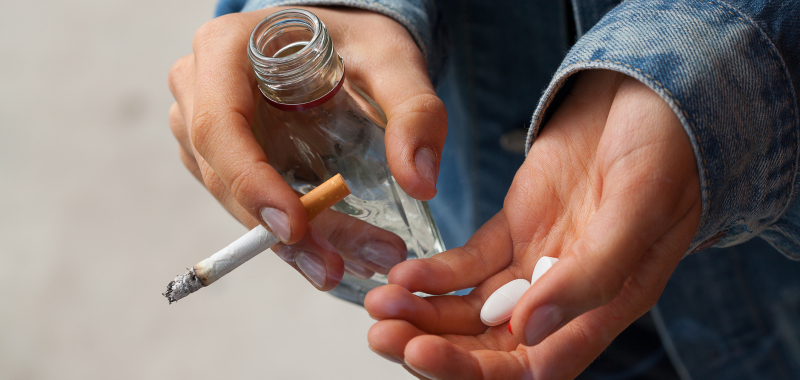
How to become addicted to drugs or alcohol is commonly misunderstood. Most people perceive addiction as something that only happens to people who are on what they think must be the wrong path, all without realizing that it’s a disease that can affect anyone, anywhere, anytime, with very little prior notice. Today, we’re going to discuss just how easy it is to slip into the addiction cycle, touching on the negative impacts that being addicted to drugs or alcohol can have on someone’s life.
Understanding Addiction
Addiction is defined by the Merriam-Webster dictionary as a “compulsive need for and use of a habit-forming substance (such as heroin, nicotine, or alcohol) characterized by tolerance and by well-defined physiological symptoms upon withdrawal.” In other words, if you’re addicted to a substance, you’re reliant on it. Without it, you experience withdrawal or the desire to use it again.
Addiction is an alarmingly common problem, affecting 1 in 10 Americans nationwide.1 Of the nearly 25 million Americans affected by addiction, two-thirds are addicted to alcohol, with marijuana, opioid pain relievers, and cocaine accounting for the majority of the remaining one-third of addicts.
But how does addiction begin? It starts at a part of the brain called the nucleus accumbens, which contains dopamine receptors. These receptors are responsible for feelings of pleasure that are associated with specific actions, such as using drugs or alcohol. When you use drugs or alcohol, the nucleus accumbens is flooded with excessive amounts of dopamine, creating short bursts of intense pleasure.
Another area of the brain, the hippocampus, is responsible for remembering these bursts of pleasure. Finally, the amygdala associates these bursts of pleasure with the usage of the substance that triggered them, which creates a subconscious connection between the usage of a particular drug and the feeling of pleasure. This subconscious association remains in your brain for an extended period, and it leads to the continued use and abuse of drugs and alcohol.
It’s possible to become addicted to drugs or alcohol after just a few pleasurable experiences. Addiction can also be influenced by a variety of physiological and biological factors such as height, weight, age, brain chemistry, and genetics. Several studies also support the association between genetics and addiction, claiming that individuals with a family history of addiction are at a higher risk of developing one themselves.
What Impact Can Drug Use Have On My Life?
The impact that drug use can have on your life is almost immeasurable, as using drugs and alcohol affect your mental and physical being in a variety of ways:
- Injuries: One of the fastest and simplest ways that drugs and alcohol can impact you is physical injury. Whether you crash a car while drunk driving, become unconscious due to an overdose, or have another type of accident while using drugs or alcohol, the opportunities to be injured while abusing a substance are endless.
- Health: Drugs and alcohol have been known to cause a wide variety of health issues, including immune system degradation, cardiovascular conditions such as heart attacks, collapsed veins, nausea and vomiting, liver failure, and seizures.
- Behavioral issues: Drugs and alcohol can alter your judgment and behavior towards others, and frequent drug and alcohol abusers may find themselves experiencing paranoia, hallucinations, impulsiveness, a lack of self-control, and impaired judgment.
- Birth defects: Approximately 5% of pregnant women in the United States use illegal drugs such as heroin, amphetamines, cocaine, marijuana, and more.2 These drugs can also affect our youngest generation, causing birth defects and withdrawal issues in newborn children, as well as premature birth. Additionally, the quality of street-level drugs can never be trusted, and drugs may contain impurities such as fentanyl that can cause additional birth defects.
Put simply, using any type of illicit substance can have serious harmful effects on your health, and using drugs and alcohol should be avoided at all costs. Note that the above impacts do not include the additional damage that may be caused by addiction. Addiction has its own set of symptoms, causes, and impacts which must be explored separately.
What Is the Addiction Cycle?
As defined by the American Society of Addiction Medicine (ASAM), a substance use disorder or addiction is a chronic disease that affects the brain’s reward, pleasure, memory, and motivation.3 Like other chronic diseases, addiction doesn’t randomly occur one day, plus it can persist for long periods and worsen over time if there is no intervention. Usually, an addiction builds up over time, causing a person who was once able to enjoy casual drinking to develop alcoholism or turn to drugs in times of hardship.
The process of developing an addiction is referred to as the cycle of addiction or the stages of addiction. The multiple stages of addiction can occur rapidly in a short period or take months to years to develop. Generally, the addiction cycle consists of these stages:
- Initial use: This refers to the person’s first-time using drugs or alcohol. It can seem unharmful, such as getting a prescription from a doctor for a painkiller after surgery or an injury or having your first drink on your 21st Regardless of the reason for the person’s initial substance use, this is normally the first stage of potential addiction.
- Abuse: The next stage of addiction is the actual abuse of the substance. Substance abuse refers to using a substance in a harmful way. At this point, the individual with the painkiller prescription may decide to take higher doses of the drug to get high or use the medication more frequently than directed. Another example of substance abuse would be binge drinking or occasional drug use. It’s not a matter of frequency, at this point, but rather a matter of causing oneself harm.
- Tolerance: When a person uses drugs or alcohol for long periods, their brain adapts to the dosage and develops a tolerance. Tolerance is when the original dosage or use of a substance no longer produces the same effects. As a result, the individual may increase their dosage or frequency to try and experience the original effect.
- Dependence: At a certain point, the individual’s brain and body become dependent on drugs or alcohol to function normally. For instance, a person at this stage of the addiction cycle who’s been using cocaine for a long time may find it impossible to experience any pleasure when they’re sober – a condition known as anhedonia. Withdrawal symptoms are also common at this stage of addiction, particularly when the individual attempts to cut back or quit their use.
- Addiction: This is a specific and chronic mental health disorder marked by certain symptoms and behaviors. These include using more of a substance than originally planned, being unable to stop using the substance, experiencing relationship problems because of substance use, and more.
- Relapse: Any chronic condition, ranging from diabetes and asthma to addiction, have the potential for relapse. In cases of addiction, relapse occurs when the person returns to drug or alcohol use following a period of abstinence. The addiction relapse rate ranges from 40% to 60%, according to the National Institute on Drug Abuse (NIDA).4
Breaking the Cycle of Addiction: Finding Rehab Near Me
If you or someone you care about is battling a substance use disorder, know that help is available. For more than four decades, our Northeast addictions treatment center has been helping thousands of people recover from drug and alcohol abuse. Through the use of our addiction treatment and detox in PA, we have been able to provide effective and quality care to all our clients.
For more information about our addiction treatment in Pennsylvania and how to get started, call Clearbrook Treatment Centers today at 570-536-9621 or send us your contact information, and our admission specialists will reach out to you as soon as possible.
Sources:
- SAMHSA – Key Substance Use and Mental Health Indicators in the United States: Results from the 2020 National Survey on Drug Use and Health
- NIH – Substance Use While Pregnant and Breastfeeding
- ASAM – Definition of Addiction
- NIH – Treatment and Recovery
Related Reading:







